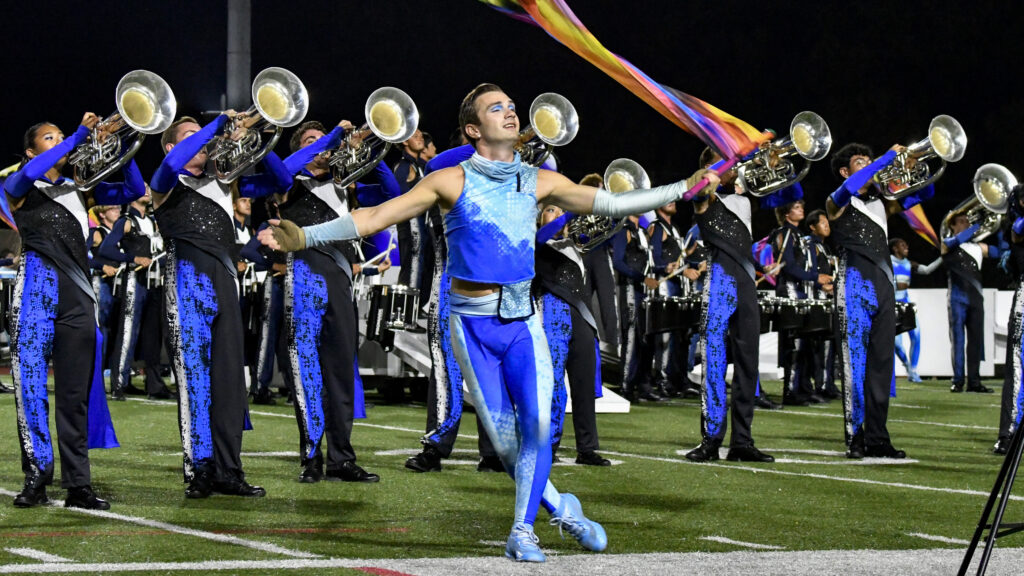The 1996 Drum Corps International Tour is often remembered for a few reasons that are unique in DCI’s history.
Just a few days before the final week of the season, the Cadets of Bergen County detoured from the DCI Tour to Atlanta to participate in the closing ceremony of the 1996 Centennial Summer Olympics, bringing drum corps to a worldwide audience. Just three days later, the corps was back to DCI competition in New Jersey, ultimately finishing the season in third, just a half a point out of first place.
The DCI World Championships went to Orlando for the first of three years in a row, celebrating the 25th silver anniversaries of both DCI and Walt Disney World. And at the end of the week, DCI experienced something that never before happened at the World Championships, a tie for the title between the Blue Devils and Phantom Regiment.

The title of Santa Clara Vanguard’s fifth-place production was “La Mer,” which is French for “The Sea” and was also the title of the Impressionistic Claude Debussy composition of 1903-1905 that opened and closed the show.
The musical Impressionism movement was concerned more with suggesting a mood and expressing subtlety rather than painting a definitive and tangible musical picture, and no one was more a master of suggesting such moods than Debussy. His “La Mer,” written in three movements, conveyed the emotions of the sea by suggesting waves, wind, power, and placidness. The work is attributed as being a major influence in the creation of film score music, such as that of John Williams.
Vanguard started the show with the first movement of “La Mer,” subtitled in English as “From Dawn to Midday on the Sea.” In the original work for symphonic orchestra, Debussy explored the moods and changes of the open waters as morning progressed from the quiet of daybreak through sometimes-tumultuous waves under the scorching sun.
The corps’ color guard members, dressed in evening gowns two colors of blue to represent different hues of the open waters, started moving to the acoustic sound of crashing waves generated by ocean drums, which are round handheld instruments with two heads encasing small metallic pieces such as bb shot. When the drums are rotated parallel to the ground, the shot moves around the inside of the shell and creates the sound of waves hitting the shore. The piece quickly built to a fanfare that featured the members of the horn line moving in abstracted undulating wave-like arcs.
After the fanfare, the corps moved from the majesty of the sea to the segment of Debussy’s first movement that conveyed the more blustery image of the vast oceans, highlighted by rapidly cresting and ebbing scale patterns in the front ensemble percussion.
That musical effect was accompanied visually by mostly white flags with a tinge of gold at the ends, the silks conveying a sense of the raging whitecaps. A short company front push to the sideline brought the waves crashing ashore at high tide, wiping the coast clean for the show to follow.

The ocean drums returned to open the ballad section of Goff Richards’ “Oceans,” a 1984 piece written for a British brass band festival in Cornwall, which is a peninsula in the very southwestern corner of the United Kingdom that is surrounded on three of four sides by the Atlantic Ocean. While much of the piece reflects the turbulence of the Atlantic, this segment explored the moments when the sea is smooth, reflecting the clouds as if a mirror.
A peanut-like shaped formation of color guard members perpendicularly intersected another peanut-like shape of brass players, the two forms passing through each other like two weather systems colliding yet peacefully coexisting. Four large pinkish flags offered some refractive color to the mistiness of a flat colorless sea, leading into two huge mirror images of arced “Vs” that intersected one another as if gentle waves passing through one another.
Vanguard primarily utilized the next piece, “Tempest Rising,” as a percussion feature, with some extended outbursts from the brass section. The piece, written by James Newton Howard, came from the 1995 Kevin Kostner science fiction movie, “Waterworld.”

For the feature, the snare drummers came up to a rack of round metallic rims that were topped by smaller rims, producing a loud clang accented by the terse hollowness of two sets of five differently-sized wooden temple blocks played simultaneously with two sets of graduated cowbells. The piece conveyed the angriest moods of the sea, the type of waters that would swallow up giant ships before lunch and leave no trace, just because they could.
The show ended with the third movement of “La Mer,” subtitled in English as “Dialog Of the Wind and the Sea.” In this movement, Debussy created a sound palette of waves rising to dynamic highs and dropping to the serene ebbing of waters gently flowing back out to sea. Those contrasts, following each other in quick succession, were heard in the rapid volume rises and falls as flags of gold, yellow, and pink cast a sparkle to the surface of the waters as if the sun was reflecting upon the waves.
At the end, giant flags of blues, purples, and yellows were unveiled, the colors bleeding into one another as all the elements of the sea get mixed up by the churning waves into a frothy mix of iridescence. The flags surrounded the brass players as the final drill formation of a giant “V” cut through the field like the prow of a great ship pulling into port.
1996 Overview

Michael Boo was a member of the Cavaliers from 1975-1977. He wrote about the drum corps activity for more than 35 years while serving as a staff writer for various Drum Corps International projects. During his lifetime Boo wrote for numerous other publications including an honors-winning book on the history of figure skating. He also was an accomplished composer. Boo passed away in 2020 and was inducted into the DCI Hall of Fame posthumously in 2021.





